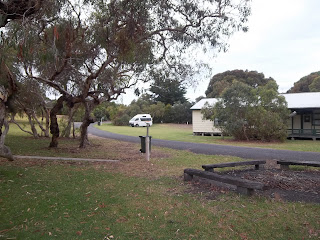We have finally arrived at Darren's house in Aldinga Beach, and I am trying to adjust to the glare and dryness of Adelaide and its surrounding areas.
But first to back track 36 hours. Southend did not get the severe storm that Adelaide received, however it did rain and the wind blew, but it was not cold, thank goodness. And no electrical storm.
Jay and Jespa having fun in the sun hills at Southend.
Yesterday we stopped in Robe for our morning cup of coffee. In this town the Christmas decorations consisted of coloured paper tied onto the verandah posts. I really like this simplified approach, rather than glaring neon Christmas lights.Then we stopped in Kingston to admire The Big Crayfish, sadly looking a little worse for wear, as did the restaurant behind it. Obviously the 'Big Things' have lost their popularity these days.
Next door was a tractor on a post, a bit like Marilyn Monroe on a post (on the NSW coast) but more practical and less glamorous. Apparently it is advertising a tractor museum.
We then drove to the Coorong, which is a National Park and lagoon eco system. The lagoon system is 130 km long and is home to many species of birds, animals and fish. The area is below sea level. One of the unique features is the interaction of water along its length with the sea water and Murray River water meeting rain water and ground water. It looks at first very uninteresting and desolate and you have to go beyond first impressions to appreciate its beauty and uniqueness. It is a very delicate eco system, and recently there were concerns about the Coorong area being destroyed due to the severe drought and irresponsible water usage of the Murray River in NSW, Victoria and South Australia.
We parked the camper van by the side of the road and continued in Darren's 4 wheel drive car on a sandy track until we reached the sea.
A deserted and wild stretch of beach beside the Coorong.
The brand new long drop toilets at a camping/picnic spot. No flies or spiders here.
The smart covered picnic shelter, with a beautiful pine table and benches, all painted with a high gloss paint.
There is water in this lagoon, first time for a number of years.
When we visited Ballarat we learned about the Chinese landing in South Australia and walking to Ballarat, in order to avoid the £10 landing fee, which the Victorian Government imposed on all Chinese prospectors. The walk to Ballarat was extremely difficult, both in length of journey and the difficult terrain. And this was especially so in the Coorong area. So the Chinese prospectors decided to build a well, and as they were meticulous craftsmen they made a well that would last.
The edges of the well were cut out of the limestone, in complete pieces and then carried some distance to the site of the well. All done by hand.
Jespa is standing in front of the finished well, still perfect after 150 years.
They also built a rest house/restaurant alongside the track, which became a road for a short while, until the main road was built. We noticed in Ballarat that the initial dwellings of the Chinese prospectors were superior in comparison to English and American prospectors, with comfortable sleeping and sitting areas, and better cooking facilities and more varied ingredients for preparing food. They also looked after each other. And this was evident again with their approach to travelling through a very difficult area of S.A.
We stopped at Gemini Downs, which is just outside Salt Creek. The camping ground is part of a working farm, and used to be run by twins, hence the name Gemini. Walter used to come here with the students of Nailsworth Secondary School, as part of their outdoor education programme. They spent time on the farm, as well as visiting the Coorong.
The farm and camping ground is now run by a son of one of the twins, and sadly it is not as well kept as it used to be. Schools no longer come here either, although church groups still use it. It is one of the prettiest camping grounds we have visited but the farmer and his wife are obviously not interested in keeping the place spic and span, nor in promoting it. When we booked in, they then decided to clean the ablution block. The unit that Darren used, had spider webs everywhere, and it was dusty and over run with millipedes. Mind you, the owners still held their hands out for the money. All in all, there were four vans in the camping area, and four units being used. Surely with Christmas holidays starting, some preparation should have been in order. We would have liked to tell the owners our views, but interestingly they were not to be found when we left! I wonder why?
Walter resting outside the unit. I came across my first Huntsman spider, three in fact, and one of them was beside my foot, which was under the table. It could have run up my leg! But I now realise that the spiders in the UK are bigger, blacker and uglier. The Huntsman, although very large, is light brown and has very dainty legs. I am still not too keen! Darren has assured me they do not live in his house.
Looking towards the bunk house and conference room, with our van in the back ground.
A collection of windmills by the Nelson river crossing.
Walter waiting patiently for the ferry to take him across the river.
Tomorrow will be unpacking day, and a much needed visit to the hairdresser for me.

















No comments:
Post a Comment